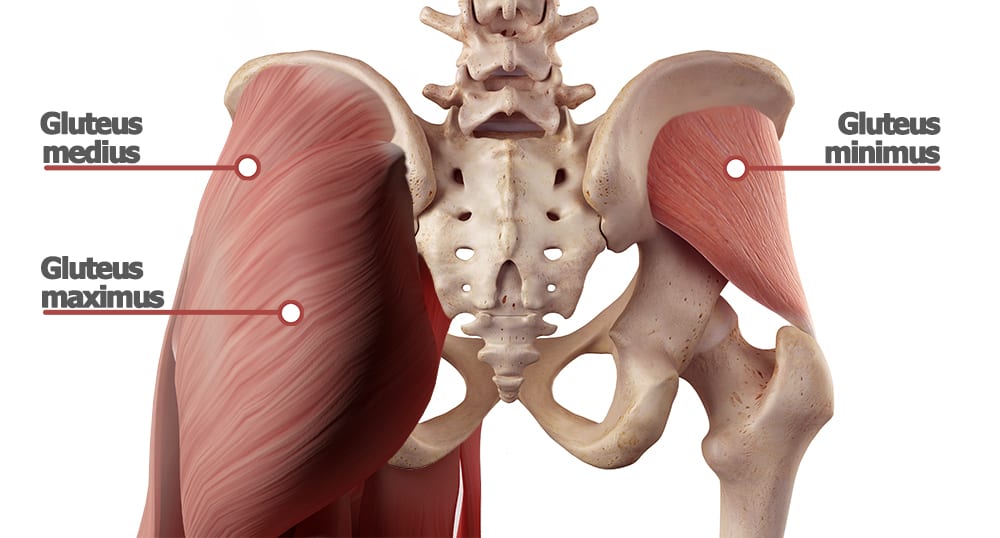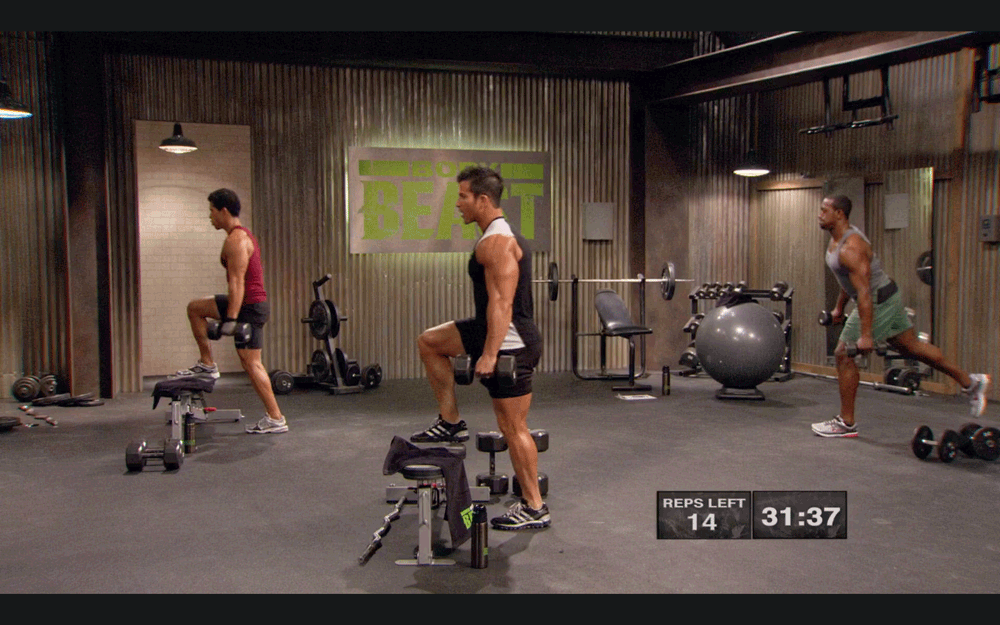If you want more power in your lower body or just want to build a bigger booty, your leg days should be focused on gluteus maximus exercises. After all, the gluteus maximus is the biggest muscle in the butt — and body.
With the proper programming, you can build strength and increase mass, which will not only enhance your rearview but also change how you feel, move, and function in everyday life.
Benefits of Gluteus Maximus Exercises
Besides the broader benefits of strength training, specifically targeting and strengthening the gluteus maximus muscles also provides some unique advantages.
1. A better-looking butt
The gluteus maximus muscle is not only the largest gluteal muscle, but also the most superficial, making it primarily responsible for the butt’s shape. Gluteus maximus exercises that build muscle mass can also help create a firmer, rounder look.
2. More power
The gluteus maximus muscle is a major source of speed and power, whether you’re sprinting up a hill, jumping up to spike a volleyball, climbing a mountain, or powerwalking down a sidewalk. In fact, one recent study found that, among 100-meter track sprinters, faster sprint times were associated with larger gluteus maximus muscles.
Even if you’re not training for an upcoming race, doing glute max exercises can help unlock your physical potential and improve your overall athletic performance.
3. Improved hip stability
While the gluteus medius and gluteus minimus are typically credited with maintaining pelvic alignment, the gluteus maximus also plays a role in stabilizing the hips. It works with the other gluteal muscles to control thigh rotation and keep the legs from collapsing inward.
4. Better posture
Additionally, strengthening the glutes can reinforce good posture. In order to stand up straight without leaning too far forward or backward, you need a stable foundation in the hips and pelvis, which is something that strong gluteus maximus muscles can help provide.
5. Reduced risk of injury
Weak glutes can negatively affect your balance, trigger movement compensations, and hijack your alignment. At best, this means you’re moving inefficiently and wasting energy. At worst, you may experience joint pain, muscle strains, and injury from misalignment and poor balance.
Thus, regularly working your glute muscles can keep you healthy and pain-free.
Gluteal Muscles Anatomy

The butt is comprised of three major glute muscles. Each is different in size, shape, and location, but they all work together to extend (straighten) the hips, rotate the thighs, and stabilize the hips and pelvis.
Gluteus maximus
The gluteus maximus is the power player and the scene stealer. It’s the biggest, strongest, and most superficial glute muscle; any discernable shape that a butt has, it owes to the gluteus maximus. Besides serving looks, the gluteus maximus is responsible for hip extension and thigh rotation.
Its origins are at the pelvis and sacrum, and it inserts into the top of the thigh bone and the iliotibial tract (a.k.a. the IT band).
Gluteus medius
In the hip or “side butt” area, you’ll find a fan-shaped muscle called the gluteus medius. The gluteus medius is a stabilizing force, helping to rotate the thigh, keep the pelvis aligned, and abduct the leg (moving the leg away from the body’s midline). This particular muscle is critical to balance and controlled side-to-side movement.
It originates at the ilium (part of the hip bone) and inserts into the top of the thigh bone.
Gluteus minimus
As its name suggests, the gluteus minimus is the smallest of the glute muscles. It’s located underneath the gluteus medius and assists it in each of its functions: thigh rotation, hip stabilization, and leg abduction.
The gluteus minimus also originates at the ilium and inserts into the top of the thigh bone.
The 11 Best Gluteus Maximus Exercises
We’ve rounded up the best gluteus maximus exercise for people who want to grow glutes and bolster their posterior strength.
1. Dumbbell squat
- Stand with your feet shoulder-width apart and parallel, holding a pair of dumbbells in front of your thighs, palms facing you.
- Draw your shoulders back, unlock your knees and engage your core as you slowly hinge at your hips, sending your butt back.
- Maintaining your lower back’s natural arch, lower the weights until your torso is nearly parallel to the floor. Keep your head neutral and the weights close to your body throughout the movement.
- When your hips can’t move any farther backward without rounding your back (you should feel a deep stretch in your hamstrings), pause, and push your hips forward to return to the starting position.
3. Glute bridge
- Lie on your back, arms down by your sides. Bend your knees and plant your feet flat on the floor with your ankles stacked under your knees.
- Pull in through your navel to brace your core muscles and then squeeze your glutes to press your hips up so your body forms a straight line — no arching — from knees to shoulders.
- Keep your head on the floor and eyes focused on the ceiling.
- Hold the position for a beat, then lift and lower. Repeat.
4. Bulgarian split squat
- Stand facing away from a bench, holding a pair of dumbbells at arm’s length by your sides. Place the tops of the toes of your left foot on the bench behind you. This is the starting position.
- Keeping your torso upright, lower your body down and back until your right thigh is parallel to the ground. Don’t let your right knee travel past the toes of your front foot or let your left knee touch the ground.
- Pause, and then reverse the movement to return to the starting position.
- Perform all reps, switch legs, and repeat.
5. Donkey kick
- Get down on all-fours, with your hands directly below your shoulders and knees directly below your hips. Your back should be flat, your neck neutral.
- Keeping your arms straight, core engaged, and knees bent 90 degrees, raise your left knee off the floor and press the sole of your left foot up toward the ceiling. Squeeze your left glute as hard as you can at the top of the movement.
- Reverse the move, lowering your left knee to the starting position.
- Repeat for the prescribed number of reps, making sure to perform an equal number with each leg.
6. Curtsy lunge
- Stand with your feet hip-width apart and your hands on your hips or holding dumbbells by your sides.
- Keeping your back flat and your core engaged, step your left foot behind and outside your right foot, lowering your hips until your right thigh is parallel with the floor. Your left knee should hover an inch or two above the floor.
- Reverse the movement to return to the starting position. Continue for reps, then switch sides and repeat.
7. Forward lunge
- Stand tall holding a pair of dumbbells at arm’s length by your sides (palms in) with your feet hip-width apart.
- Keeping your chest up, shoulders back, core braced (imagine someone is about to hit you in the gut), and back flat, take a large step forward with your right foot. Lower your body until your front thigh is parallel to the ground and your rear knee is bent 90 degrees (it should hover a couple of inches above the floor).
- Pause, and then reverse the movement to return to the starting position. Repeat, this time stepping forward with your left foot. Continue alternating legs with each rep.
8. Camel
- From a kneeling position, with your butt resting on your heels and the tops of your feet on the floor, hold a heavy dumbbell at your chest with both hands.
- Keeping your chest up, shoulders back, and core engaged, squeeze your glutes as you push your hips forward to full extension, shifting your weight onto your knees.
- Pushing your hips back, slowly lower your butt back down onto your heels, and repeat for reps.
9. Hip thrust
- Sit on the floor with your back against the long edge of a gym bench and your feet flat on the floor (if using weights place a barbell across your waist). The bench’s pad should be positioned just under your shoulder blades.
- Engage your core and push through your heels to lift your hips toward the ceiling, keeping your chin tucked to prevent your back from arching excessively.
- Squeeze your glutes to reach the top of the movement, where your ankles should be stacked under your knees, creating a 90 degree bend in your legs. Then slowly lower your butt back to within a few inches of the floor before repeating.
10. Step-up

- Stand tall holding a pair of dumbbells at arm’s length by your sides, and place your whole right foot on a bench so that your hip, knee, and ankle are all bent 90 degrees.
- Keeping your chest up and shoulders back, push your body up with your right leg until it’s straight (keep your left foot elevated).
- Pause, and then lower your body back to the starting position under control. Perform equal reps on both legs.
11. Jumping lunge (split jump)
- Stand in a staggered stance with your right foot about two to three feet in front of your left foot. Let your arms hang by your sides.
- Keeping your chest up, back straight, and core engaged, lower yourself into a lunge: front thigh parallel to the floor, rear knee bent to about 90 degrees.
- Jump straight up so that both feet leave the floor. Swing your arms up in front of your chest will help optimize your momentum and power.
- Switch leg positions in the air, landing softly with your left foot forward.
- Immediately lower your body back into a lunge to begin your next rep.
- Continue alternating legs with each rep.
The post Build a Fuller, Stronger Butt With These 11 Gluteus Maximus Exercises appeared first on BODi.

0 Comments